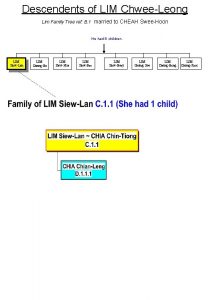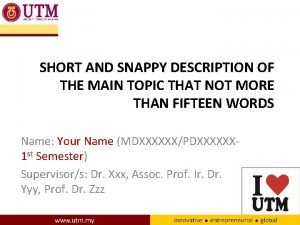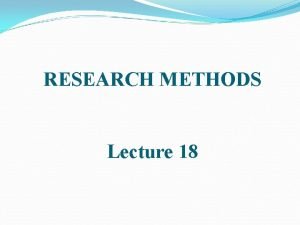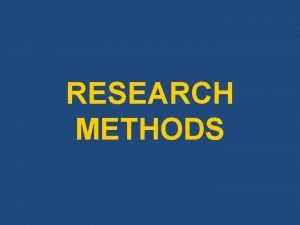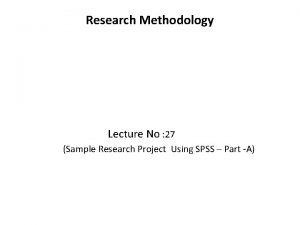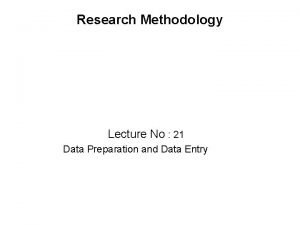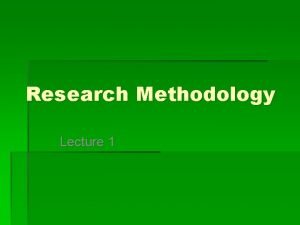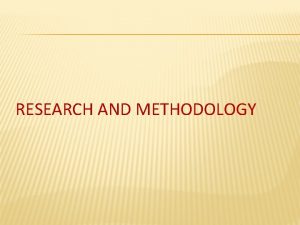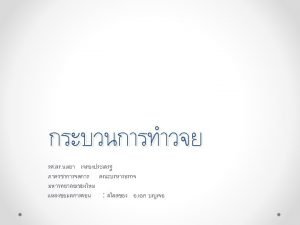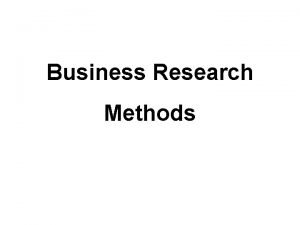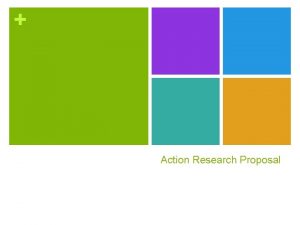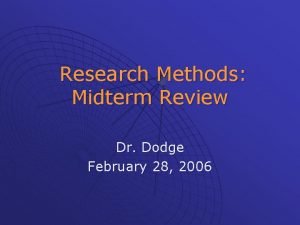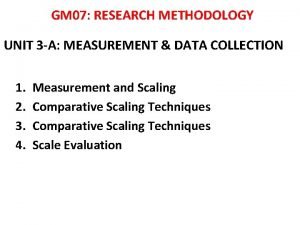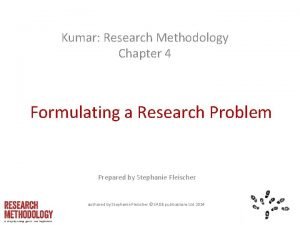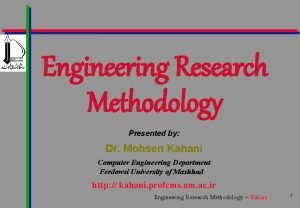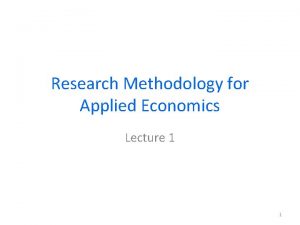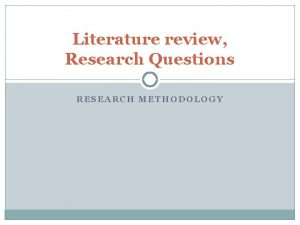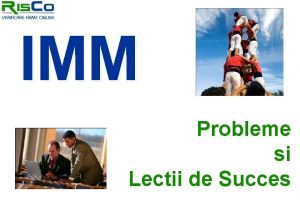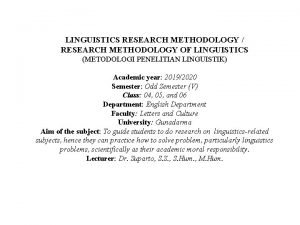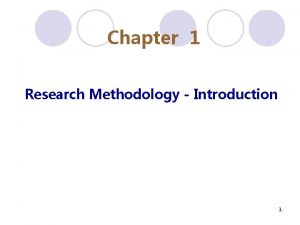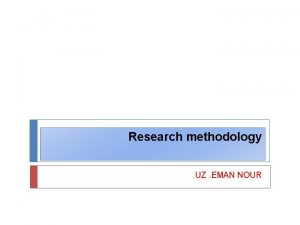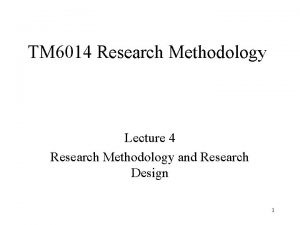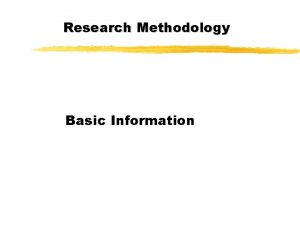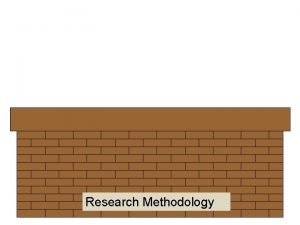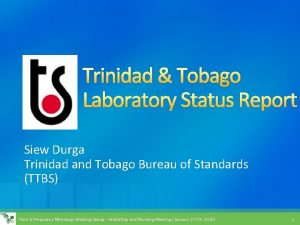RESEARCH METHODOLOGY ASSOCIATE PROF DR NG SIEW IMM


















































- Slides: 50

RESEARCH METHODOLOGY ASSOCIATE PROF DR NG SIEW IMM (SERENE) ASSOCIATE PROF DR HO JO ANN

WHAT IS RESEARCH? �Research is about acquiring knowledge and developing understanding, collecting facts and interpreting them to build up a picture of the world around us (Walliman, 2011).

WHAT IS RESEARCH METHODOLOGY? �Research methodology refers to a systematic way to solve the research problem or to answer the research questions. § Looks at the various steps that are generally adopted by a researcher in studying the research problem.

AGENDA ü Qualitative versus Quantitative Method Selection Criteria ü Research Paradigm for Quantitative Method ü Quantitative Method using Questionnaires ü Sampling Technique for Quantitative Method ü Sample Size for Quantitative Method 4

QUALITATIVE VERSUS QUANTITATIVE METHOD SELECTION CRITERIA

WHICH RESEARCH APPROACH TO TAKE? Quantitative? Qualitative? A combination of both? Selection Criteria

QUALITATIVE OR QUANTITATIVE OR COMBINATION? Selection Criteria Depends on: 1. your research questions 2. your skills and abilities 3. your supervisor’s preferences 4. accessibility to the data 5. the feasibility within the available resources of time (and money) 6. your research paradigm (positivist or constructionist) 7

Selection Criteria RESEARCH PARADIGM FOR QUANTITATIVE METHOD (OUR WORLD VIEW) Ontology: What is reality? Epistemology: What is our relationship with the knowledge that we are discovering? Are we part of the knowledge? Axiology: Role of values Positivism (Quantitative) Interpretivism (Qualitative) Reality is objective and Singular; independent from the researcher Reality is subjective and multiple as seen by the participants Researcher is independent from that being researched. Knowledge is objective and governed by laws/theories. Researcher interacts with that being researched. Knowledge is something that is interpreted by the individuals Value-free Value-laden

THE LINK BETWEEN RESEARCH PARADIGM AND THE METHODOLOGY Selection Criteria

QUANTITATIVE RESEARCH METHOD USING QUESTIONNAIRES

Quantitative QUANTITATIVE RESEARCH • Refers to a deductive, theory-testing, objective and positivist process where scientific methods are applied to the study of people/organization/country. • Best suited to questions which seek differences within and across categories or discovering social trends. • Data collection methods are experimental studies and surveys.

Quantitative EXAMPLES OF RESEARCH QUESTIONS q Is there a relationship between uncertaintyavoidance and intention to visit New Zealand? q Do Malays, Chinese and Indians have different ethical perceptions? q What is the relationship between job insecurity and role overload on the surviving employees’ turnover intention?

Quantitative QUESTIONNAIRES • Questionnaires are a series of questions that the respondent answers on their own. • Most common quantitative method for postgraduate students. • Suitable for collecting data on relatively simple topics, and for gaining a general overview of an issue. • Questionnaires need to have clear questions, an easy to follow design and not be too long.

Quantitative QUANTITATIVE METHOD USING QUESTIONNAIRES Step 1: Identify measurement scales Step 2: Create a measurement Table Step 3: Develop the questionnaire Step 4: Prepare a cover letter Step 5: Pre-test the questionnaire Step 6: Distribute the questionnaire Step 7: Analyze the Data Step 8: Report Findings

Quantitative STEP 1: IDENTIFY MEASUREMENT SCALES § Identify variables from your hypothesis (developed from literature) § Find relevant measurement scales for each variable Example: H 1: Uncertainty-avoidant people will have a less positive intention of visiting New Zealand - requires finding appropriate measurement scales for two variables: 1) uncertainty avoidance 2) intention to visit New Zealand.

Quantitative STEP 2: CREATE A MEASUREMENT TABLE • A measurement table is a checklist to ensure measurement items of all variables are included in the questionnaire

Quantitative STEP 3: DEVELOP THE QUESTIONNAIRE • Convert all items in measurement table into questionnaire format

Quantitative STEP 3: DEVELOP THE QUESTIONNAIRE (CON’T) • Identify demographic variables to classify respondents

Quantitative STEP 4: PREPARE A COVER LETTER • To explain objectives of study • To solicit and encourage participation • To address the issue of confidentiality

Quantitative STEP 5: PRE-TEST THE QUESTIONNAIRE • To determine the time taken to complete the questionnaire. • To check whether respondents understand the instructions • To check whethere are unclear or ambiguous questions • To check response categories are exhaustive and mutually-exclusive • To provide an idea of the reliability and validity of the measurement questions

Quantitative STEP 6: DISTRIBUTE THE QUESTIONNAIRE Postal Online Delivery and collection Collective administration

STEP 7: ANALYZE THE DATA Quantitative Software for Quantitative Data Analysis: 22

STEP 8: REPORT FINDINGS Quantitative • Descriptive • Inferential 23

Quantitative ANALYSIS – DESCRIPTIVE STATISTICS 24

Quantitative ANALYSIS - INFERENTIAL STATISTIC 25

Quantitative ANALYSIS - INFERENTIAL STATISTIC 26

Quantitative RESULTS 27

Quantitative CONCLUSION 28

Quantitative QUANTITATIVE METHOD USING QUESTIONNAIRE Step 1: Identify measurement scales Step 2: Create a measurement Table Step 3: Develop the questionnaire Step 4: Prepare a cover letter Step 5: Pre-test the questionnaire Step 6: Distribute the questionnaire Step 7: Analyze the Data Step 8: Report Findings

SAMPLING FOR QUANTITATIVE METHOD

EXHIBIT 16. 1 STAGES IN THE SELECTION OF A SAMPLE 16– 31 © 2013 Cengage Learning. All Rights Reserved. May not be scanned, copied or duplicated, or posted to a publicly accessible website, in whole or in part.

EXHIBIT 16. 2 MAILING LIST DIRECTORY PAGE 16– 32 © 2013 Cengage Learning. All Rights Reserved. May not be scanned, copied or duplicated, or posted to a publicly accessible website, in whole or in part.

PROBABILITY VERSUS NONPROBABILITY SAMPLING Probability Sampling § A sampling technique in which every member of the population has a known, nonzero probability of selection. § Use when need to answer research questions that require statistical estimation on the characteristics of the population from the sample, generalized results to population. § Can be used when sampling frame is available § Often associated with Survey or Experimental research strategies 1 33 – 6

PROBABILITY VERSUS NONPROBABILITY SAMPLING Nonprobability Sampling § Use when sampling frame is not available § A sampling technique in which units of the sample are selected on the basis of personal subjective judgment or convenience. § The probability of any particular member of the population being chosen is unknown. § Often associated with Case Study research strategies, where in-depth study on only a few cases are involved to gain theoretical insights. § Result not generalizable to population § Able to sample purposively and reach difficult to identify members of population 1 34 – 6

CHOICE OF SAMPLING TECHNIQUE IS DETERMINED BY Research questions/objectives: if need to estimate statistically the characteristics of the population from a sample (generalize result to population) require probability techniques; if do not require generalizations, can make use of non-probability sampling technique. Availability of sampling frame: probability techniques requires some form of sampling frame, when sampling frame is not available, need to use non-probability sampling techniques. Availability of resources e. g. financial and time For many research projects, you will need to use a combination of different sampling techniques © 2013 Cengage Learning. All Rights Reserved. May not be scanned, copied or duplicated, or posted to a publicly accessible website, in whole or in part. 35

QUANTITATIVE VERSUS QUALITATIVE STUDY 1. Sample size requirement for quantitative study and qualitative study is different. 2. Quantitative study aims to generalize the results to the population, thus bigger sample size is required. 3. Qualitative research, seeks to gain “indepth understanding”, thus tend to choose sample who has rich experience relating to the phenomenon of interest. Generalizability is not the priority. 1736 © 2013 Cengage Learning. All Rights Reserved. May not be scanned, copied or duplicated, or posted to a publicly accessible website, in whole or in part.

DETERMINING SAMPLE SIZE 1. use sample size calculator that is available on line. It was calculated following Krejcie and Morgan (1970) Table as follow: ü Key in population size, confidence interval 5% and confidence level of 95%, sample size required will be generated for you. ü For instance, for a population size of 30, 000, sample size generated is 379. Determine Sample Size Confidence Level: 95% 99% Confidence Interval: Population: Sample size needed: 1737 © 2013 Cengage Learning. All Rights Reserved. May not be scanned, copied or duplicated, or posted to a publicly accessible website, in whole or in part.

2. follow statistical rule ü the desired ratio of sample size to construct numbers should be 20: 1 (Hair, Anderson, Tatham and Black 1998). ü When this ratio is observed, the result should be generaliazble if the sample is representative. 1738 © 2013 Cengage Learning. All Rights Reserved. May not be scanned, copied or duplicated, or posted to a publicly accessible website, in whole or in part.

3. a minimum sample size of 30 is required for statistical analysis of each category within the overall sample. ü This is because only sample size of 30 or more produce a sampling distribution that is very close to a normal distribution that allows statistical analysis to be performed (Stutely, 2003). ü Thus, in the case of a sub-category in the population that has less than 30 units, all units should be included as sample. 1739 © 2013 Cengage Learning. All Rights Reserved. May not be scanned, copied or duplicated, or posted to a publicly accessible website, in whole or in part.

4. Effect Size G*Power 3 software by Faul et al. (2007) The effect size use is 0. 15, margin error of 5%, power of (1 -β) = 80%, E. g. 30 number of predictors (30 items of a formative measure) and the results indicated that the minimum sample size that should taken into consideration is 187 respondents with the power of 0. 80 (Hager, 2006). 1740 © 2013 Cengage Learning. All Rights Reserved. May not be scanned, copied or duplicated, or posted to a publicly accessible website, in whole or in part.

PROBABILITY SAMPLING Simple Random Sampling § Assures each element in the population of an equal chance of being included in the sample. § Use random number to select sample without bias, can be said to be representative of the whole population § Inappropriate to use if population covers a large geographical area and require face to face contact, random selection means selected cases are likely to disperse throughout the area and results in high travel costs. § However, if alternative data collection techniques like internet-based, postal or telephone interview, simple random would still be suitable 1 41 – 6

PROBABILITY SAMPLING Systematic Sampling § A starting point is selected by a random process and then every nth number on the list (sampling frame) is selected. § In some instances, it is not necessary to actually construct a sampling frame, e. g. online pop-up questionnaires § Every tenth visitor to the site over a specific period of time are invited in the survey to participate 1 42 – 6

PROBABILITY SAMPLING Stratified Sampling § Simple random subsamples that are more or less equal on some characteristic are drawn from within each stratum of the population. § The sampling frame is divided into a number of subsets (e. g. managers versus non-managers) and samples are selected from each subset/strata randomly. § The extra step needed to identify distinguishable strata within a population means it is likely to take longer, more expensive, and more difficult to explain than simple random or systematic random sampling 1 43 – 6

CLUSTER SAMPLING Allows focusing on a few (e. g. four) geographical clusters from the high number of geographical areas in the country (population), selecting clusters randomly makes cluster sampling a probability sampling technique. Travelling and interviewing elements in a few geographical clusters, reduces time and cost. Restricting sample to a few geographical clusters maximizes the amount of data you can collect using face-to-face methods within the resources available However, you need to maximize the number of clusters covered to increase the amount of variation in the population 1 44 – 6

NONPROBABILITY SAMPLING Convenience Sampling • Obtaining those people or units that are most conveniently available. • E. g. person interviewed in a shopping centre • While this may not be problematic if there is little variation in the population, where the population is more varied, it can result in participants that are of limited representation of population • E. g. taking part-time MBA students as surrogate for managers, bias in educational background, thus interpretations should be treated with caution 1 45 – 6

NONPROBABILITY SAMPLING Judgment (Purposive) Sampling • An experienced individual selects the sample based on personal judgment about some appropriate characteristic of the sample member. • E. g. using case study strategies, intend to select small samples and wish to select cases that are most informative • E. g. only select those who travelled overseas in the last two years 1 46 – 6

NONPROBABILITY SAMPLING (CONT’D) Snowball Sampling § A sampling procedure in which initial respondents are selected by probability methods and additional respondents are obtained from information provided by the initial respondents. § Used when difficult to identify members of the desired populations § e. g. people who are working while claiming unemployment benefits. § E. g. breast cancer patient survivors 1 47 – 6

NONPROBABILITY SAMPLING (CONT’D) Quota Sampling § Quota sampling is a type of stratified sample except that selection of cases within a strata is entirely non-random. § Quota sampling has similar sample size requirements as probabilistic sampling techniques. § Cheaper, faster and sampling frame not required. § Quota used include age, gender and social class. § Interviewer decide who to interview until they have completed quota given to them for each strata 1 48 – 6

TALK SUMMARY ü Qualitative versus Quantitative Method Selection Criteria ü Research Paradigm for Quantitative Method ü Quantitative Method using Questionnaire ü Sampling Technique for Quantitative Method ü Sample Size for Quantitative Method Take workshops /courses that will help build your methodology competencies

 Ng siew imm
Ng siew imm Cec bank hala centrala iasi
Cec bank hala centrala iasi Imm
Imm Imm ftui
Imm ftui Diana siew
Diana siew Dr neoh siew hong
Dr neoh siew hong Question of dowry
Question of dowry Lim chong eu family tree
Lim chong eu family tree Cerpen pungut tingkatan 5
Cerpen pungut tingkatan 5 Group studied is smaller and not randomly selected
Group studied is smaller and not randomly selected Objectives of research problem
Objectives of research problem What are variables in research methodology
What are variables in research methodology Objectives in research methodology
Objectives in research methodology Research methodology flow chart
Research methodology flow chart Steps of research proposal
Steps of research proposal Criteria of goodness of a measurement scale
Criteria of goodness of a measurement scale Dimensions in research
Dimensions in research Methodology vs. method
Methodology vs. method Methodology of project proposal sample
Methodology of project proposal sample Field editing and central editing in research
Field editing and central editing in research Process of research definition
Process of research definition Examples of continuous variables
Examples of continuous variables Independent variable meaning in research
Independent variable meaning in research Ocjs grants
Ocjs grants Methodology definition
Methodology definition Type of research methodology
Type of research methodology Research process flowchart
Research process flowchart Data collection procedure and data analysis
Data collection procedure and data analysis Design research methodology
Design research methodology Chapter 3 research qualitative
Chapter 3 research qualitative Types of research methodology
Types of research methodology Methods of factor analysis in research methodology
Methods of factor analysis in research methodology Cover page of research proposal
Cover page of research proposal Ocar structure
Ocar structure Confounded relationship in research methodology
Confounded relationship in research methodology Research methodology lecture notes doc
Research methodology lecture notes doc Midterm exam for applied research methods
Midterm exam for applied research methods Methodology in research
Methodology in research Methodology in research paper example
Methodology in research paper example Methodology in research
Methodology in research Non conclusive research design
Non conclusive research design Research methodology chapter 4
Research methodology chapter 4 Engineering research methodology
Engineering research methodology Causal research design
Causal research design True or false questions on research methodology
True or false questions on research methodology Research methodology in applied economics
Research methodology in applied economics An advantage of field research is
An advantage of field research is Interview method of data collection
Interview method of data collection Exploratory verbs in qualitative research
Exploratory verbs in qualitative research Different philosophy
Different philosophy Brajuha research
Brajuha research







